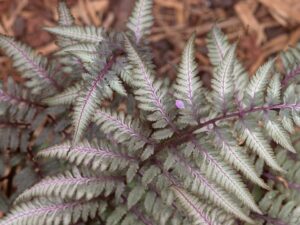 I have friends and relatives who are nuts about ferns, from great big ostrich ferns to small ground-hugging varieties. In spring, these fern lovers take walks in damp, muddy woods just to see the young fronds, or fiddleheads, before they unfurl. In summer, they pour water on their prized ferns to keep them from curling up and disappearing. In fall and winter, they may even imitate the hobby of middle class and wealthy Victorians and attempt to grow ferns indoors.
I have friends and relatives who are nuts about ferns, from great big ostrich ferns to small ground-hugging varieties. In spring, these fern lovers take walks in damp, muddy woods just to see the young fronds, or fiddleheads, before they unfurl. In summer, they pour water on their prized ferns to keep them from curling up and disappearing. In fall and winter, they may even imitate the hobby of middle class and wealthy Victorians and attempt to grow ferns indoors.
The fern-o-philes in my life may not be aware of it, but they are heirs to a proud tradition. Fern fascination has long led wealthy people to create fabulous fern gardens. Humbler gardeners, looking for the tranquility that seems to be inherent in lacey green fronds, have often stocked any available shady space with as many ferns as possible.
I have always appreciated the value of ferns in the landscape, but I didn’t really warm up to the plants until I discovered Athyrium niponicum var. pictum, otherwise known as Japanese painted fern. Its configuration is typically ferny, with deeply dissected, vaguely triangular fronds that arch gracefully, rising to about 18 inches. The spread is wider, with the fronds on a healthy plant growing up to 20 inches long. Depending on the variety, those fronds may be gray or silvery green, with contrasting ribs or stems in red or maroon. They may also be crested on the ends.
Catalog and online vendors may wax poetic, but there is no descriptive passage that begins to convey the magic of the Japanese painted fern. A single plant is beautiful—teasing the eye with a clump of mesmerizing silvery swirls. A mass-planting looks like a tapestry in motion. I remember visiting one local garden that featured a large corner bed planted entirely in Japanese painted ferns. The shady plot was tucked away behind a large swimming pool surrounded with flashy tropical specimens. Despite the drama of the pool and the gaudy hibiscus and canna blooms, the ferns’ poetry in motion put that display in the shade—literally and figuratively.
Ferns do not flower or set seeds, reproducing either by spores or by the spreading rhizomes that anchor and nourish the plants. The beauty of Japanese painted ferns, which are native to East Asia, has led breeders to attempt improvements on nature. The array of available cultivars is almost dizzying. For the best silver swirls, try varieties like the classic ‘Pictum’, or ‘Silver Falls’, most likely a ‘Pictum’ offspring with even more silvery-gray color.
Red, pink or maroon is striking against silvery gray, and merchants carry a number of varieties with that color combination. ‘Red Beauty’ features dark red stems and veins against pewter background, and ‘Burgundy Lace’ boasts purplish young fronds that mature to gray-green, accented by darker red midribs. The same is true of ‘Ursula’s Red’, except that the areas of the fronds nearest the central midribs are blushed with rosy pink.
Some Japanese painted ferns, like ‘Wildwood Twist’, improve on older varieties with fronds that twist along their lengths. Others, including ‘Crested Surf’, feature rising “crests” at the ends of the fronds.
Whatever varieties take your fancy, make sure to grow them in the right conditions for optimum health and color. Partial shade is an imperative, as is very consistent moisture. If your chosen spot tends to perpetual damp shade, all the better. Prolonged drought will make the plants curl up and die, or at least take up dormancy until the next year.
If you are new to painted ferns, plant them in the spots where hostas grow well. The two genera grow nicely side by side, and tend to complement one another.
Japanese painted fern clumps will grow larger over time if they are happy, and can be divided by digging up the plant and cutting apart the rhizomes and roots to create healthy divisions.
Generally hardy in cold weather climates up to USDA Plant Hardiness Zone 3, the beautiful fronds will disappear during the winter months. If you are a container gardener, place the containers in protected spots or unheated garages for the winter and watch for the plants’ emergence in spring, making sure to start watering when that happens.
When spring rolls around, most garden centers will carry at least one Japanese painted fern variety, most likely ‘Pictum’, which is beautiful and has stood the test of time. Online vendors will offer more choices, and it is worth seeking them out to create your own personal fern tapestry.
